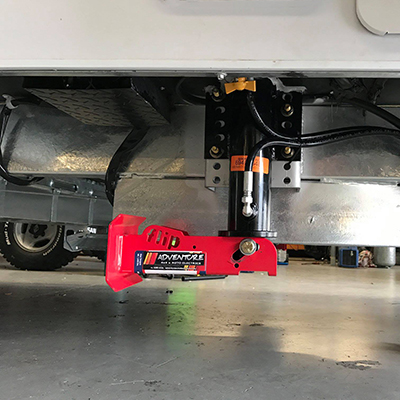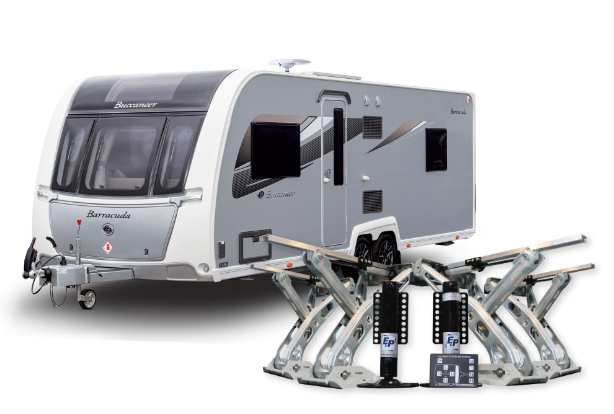So in my previous post, I covered how to level a twin-axle caravan using a couple of methods such as the curved blocks and Lock n Level system.
Today I wanted to cover aftermarket self-levelling devices that you can have installed on your caravan and the various option available to you.
Like motor movers, self-levelling systems are a big investment into your overall caravan set-up – especially hydraulic systems.
But for some, the benefits will far outweigh the cost – for example, if you have a serious mobility issue, then a self-levelling system will enable you to continue caravanning with ease.
Currently, there are two specific systems to level a caravan – the hydraulic and the motor mover.
Both require the use of the leisure battery, so you will need to make sure yours is in good working order – ideally at 100ah plus output.
The hydraulic system works by using pressurized oil to do the heavy lifting, which is controlled by a pump that runs off the battery.
Hydraulic Automated Caravan Self-Levelling Devices – Where to Buy?
Currently, the only manufacturer of hydraulic caravan self-levelling systems is E&P Hydraulics. Using their approved partner search, you can find an approved installer in your area.
E&P Hydraulics’ levelling systems for caravans are suitable for most single and twin-axle chassis.
The hydraulic feet or ‘jacks’ are attached to the chassis with adapters that are designed to match your caravan body, which means no welding is necessary and any existing warranties will remain intact.

The E&P system comes in 3 levels:
Level M, Level C and Level C Compact
Level M – is for installation on a motorhome
Level C – is for installation on caravans (twin and single axle)
The ‘Complete system’ works using two hydraulic jacks that will level the van side-to-side, then the corner steadies are lovered to level front-to-back.
Level C Compact – this is also for caravans but is a side-to-side system, so you will need to manually level front to back using the steadies and jockey wheel.
Both Caravan systems will work if you have a motor mover installed.
If you are in the market for a new caravan and have the ‘premium’ budget required – there are two manufacturers that already have self-levelling systems included.
These are the Elddis Buccaneer and the Lunar Alria
It’s also worth checking out The Buccaneer Galera 2017 onwards for a cheaper used model.
How Does a Hydraulic Self-Levelling System Work?
E&P claim that once their system is installed you can level the caravan with the push of a button in 2 minutes!
Two hydraulic feet or jacks are fitted on either side of the caravan axle. The feet lower, giving 170 bar of hydraulic pressure that raises and levels the caravan on either side. Finally, the four corner steadies lower – levelling the caravan from front to back.

Can I Get Rid of my Levelling Blocks?
E&P state that this system will eliminate the need for any additional levelling blocks – BUT I think you still need them if for example you are pitched on wet grass. The E&P feet do have a larger surface area, but you will still need some type of wood or block underneath to help prevent sinking.
You might also want to think about if your battery fails for any reason – you might still need those blocks!
Winter Storage and Tyre Protection
E&P state that you can raise the caravan whilst in storage so that the tyres are completely off the ground, thus protecting the tyres from perishing.
They also state that the system is safe to use to raise the caravan enough to change a tyre.
If the battery was to fail for any reason – the system does have the capacity to retract the legs in an emergency by connecting the system to the car’s 12v battery. You can also retract the legs manually if you need to.
What About my Payload?
As I mentioned this is a hydraulic system and is very strong, so naturally you would assume it is very heavy.
E&P state that the weight added is around 25kg for caravans and 55kg for motorhomes up to 5.5 tonnes GVW. Don’t forget to factor this (and your motor mover) in with your towing weights!
Ok, I’m in! How Much Does it Cost?
Well, this is where the ouch moment comes in! For the Level M (motorhome system) you can expect to pay around £6000. For Level C you will be paying around £3000, and for the Level C Compact, you should look to pay around £2000.
Motor Mover Based Automated Caravan Self Levelling System
Next, we’re onto the Motor Mover-based levelling system. An alternative to the hydraulic system, the only current manufacturer of this kind is made by a company called Emove.
How does a Motor Mover Automated Self-Levelling System Work?
You can see exactly how this system works by watching the video below:
The complete system includes the motor mover x2, motorised corner steadies, gyroscope and remote control.
Emove claim that you can level your system in around two minutes – the same as E&P.
So the first thing the Emove remote does is to tell you where you need to place the levelling ramp. As the system will work to a maximum 18% gradient, this should be sufficient even on very uneven pitches.
So basically, the indicator on the remote will tell you where to place the ramp under one of the wheels.
You then press ‘FL’ on the remote. The caravan will proceed up the ramp and once it has found the correct level the steadies will come down and level front-to-back.
This sounds straightforward enough, but be aware that if the Emove hasn’t found its level and the caravan is at the top of the ramp – don’t let the wheels roll off the edge!
Emove Finding Level Kit – the Downsides
At the time of writing the Emove system is only available for single axle caravans, with a weight up to 1800kg, however, I would expect this to change soon enough as the demand is there.
Price of Motor Mover Self-Levelling Kits
The Emove Finding Level kit including two motor movers and 4 motorised corner steadies comes in at around £2000.
If you’ve got the know-how, you can install this kit yourself – otherwise, you will need to factor in installation costs of around £200.
The hydraulic system needs to be fitted by an approved installer.
So all in, the Emove is significantly cheaper than the hydraulic option.
So Which Caravan Self-Levelling System Should you Buy?
If you really wanted to go for an automated levelling system then I would personally go for the Emove system.
If you already have a motor mover installed, it can easily be turned into an automated levelling system.
It’s also cheaper than the hydraulic system – but it’s only available to single-axle caravans.
You can also check out our other post for some alternative (and cheaper) levelling options!
FAQ’s
What is the maximum angle the caravan levelling system will auto level to?
The E&P system can level to a gradient of around 5% whereas the Emove system states that it can level to an 18% gradient. Any steeper, then you will need to use additional blocks.
Can a Self-Levelling Kit be Swapped from One Caravan to Another?
Yes, you can swap over to another caravan – this will obviously incur additional costs. Bear in mind that the Emove Find Level system will not work on a twin axle.
Do Self-Levelling Systems use the Caravans Leisure Battery?
Yes, both systems require the use of the battery. Make sure it’s in good working order and fully charged. If the batter was to fail for any reason, you can hook it up to the electrics on site, use the car battery or manually wind down.
How much Power does the Hydraulic Pump Use?
The E&P system uses a 240-watt motor – since both systems take around 2 minutes to level the caravan this should be no issue with a decent, fully charged leisure battery.
What Weight of Caravan can each Self-Levelling Kit Lift?
The E&P system can lift around 3500kg, while the Emove system can lift around 1800kg – so pretty much any caravan on the UK market would be suitable for either system (apart from Emove only being suitable for a single axle).

